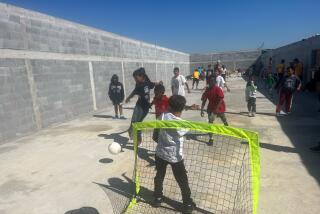A Stitch in Time?
Mark Elinson was trying to find a human rights issue that would light a fire in his students. Then, in the summer of 1996, the international law teacher at L.A.’s James Monroe High Law and Government Magnet School began hearing about efforts to combat child labor around the world.
Among the information he gathered was a Life magazine article about children in Pakistan spending long hours sewing together the small leather panels that make up a soccer ball. Sewing involved sitting hunched over, their backs arched in a curve as round as a comma, an awkward position that could permanently damage the spine if held for hours at a time and for many days. Needle punctures were common.
Worse, according to the magazine story, the children in Sialkot were being paid the equivalent of six cents an hour to sew expensive balls that later sold under the brand names of some of the richest sporting goods companies in the world. An accompanying photo showed a boy sewing while sitting behind a completed ball with a Nike “swoosh” logo on the side. As it turned out, other companies, including Adidas and Reebok, were contracting with ball makers in the town, where at the time the vast majority of the world’s tournament-level soccer balls were made.
Most American players had no inkling of the toil that went into producing the leather balls they dribbled around their soccer fields. But Elinson’s students, some of them soccer players, finally lit up. “They really connected,” Elinson recalls.
The students looked for a way to do something to make a difference to child laborers around the world. Six of them testified before the Los Angeles Board of Education, which oversees the nation’s second-largest school district, urging the board to make sure that the 800 balls it buys each year were not made by children. The district joined an international boycott of child-made balls that eventually helped spur Nike, Adidas and other brand-name companies, the Pakistani soccer ball makers, the International Labor Organization and other organizations working in the soccer ball-making region of Pakistan to work together to try to get children out of the ball factories and into school.
In each of the four years since, Elinson’s fall semester class has repeated its anti-child labor efforts. The North Hills students are not alone. They are part of a global outcry against child labor that has burgeoned in the last decade. But as the United Nations General Assembly meets later this week in a special session on children, the question of how to convert that outrage into useful action remains the topic of much debate.
The International Labor Organization estimates that 250 million children between the ages of 5 and 14 work part or full time around the world. Unofficial estimates put the number at perhaps twice that.
They work at many jobs, as the photographs and stories on these pages show. They scavenge for recyclables in giant, foul-smelling dumps. They sell trinkets, water, gum, sometimes even their bodies, on city streets. They mine gold, work in leather factories, repair cars and breathe metal dust while sharpening the fine edges of surgical instruments. By far the largest number work in agriculture, where they are exposed to toxic chemicals and work so many hours that they perform poorly in school or drop out altogether. They suffer abuse in helpless isolation as domestic maids. Sometimes they die, as dozens of third- and fourth-grade students did in March during an explosion in a remote eastern Chinese village. Their schoolhouse was being used as a fireworks factory.
In the decade since the first U.N. special meeting on children, the global family has made real progress toward raising awareness about child labor, and figuring out how to tackle it. Back then, studies about the problem and public protests against child labor were scarce. Many government officials denied that their country’s children worked at exploitative jobs. The term “child labor” itself became, as it remains, the subject of controversy: At what age does a young person stop being a “child”? What work should a child be allowed to perform? After-school baby-sitting? Acting? Sewing soccer balls? What if the child’s other options are worse?
Although these debates continue, the intervening years have brought some resolution. In 1999, the ILO unanimously passed a new convention that specified the “worst” forms of child labor. Even poor governments agreed through the unanimous vote that they should, and could, fight to eradicate child slavery, prostitution, drug-running and other work that harms children physically, mentally or “morally.”
Today, condemnations of child labor appear in places both obvious and obscure. “Stop child labor” is a refrain at anti-globalization rallies around the world. Articles about child labor not only appear in mainstream news outlets but also in lighter fare, such as Seventeen and People magazines. Even Hollywood scriptwriters have gotten into the act, working the term “child labor” into scripts for shows ranging from “The West Wing” to “The Simpsons.”
Governments once reluctant to take action are trumpeting their new initiatives. In Morocco, young King Mohammed VI has launched a national campaign against child labor. Other lower-profile, but successful, efforts to protect working children are taking place all over the globe. In rural Brazil, families that promise to send their children to school can borrow a goat for breeding and keep the offspring. Police in Thailand have raided brothels holding child prostitutes. Some Pakistani parents are demanding better government schools. Children themselves have become powerful advocates against exploitation and abuse, although, like adults, they don’t always agree. Some even believe that boycotting child-made products is worse than buying them, arguing that children should be allowed to work, although in better conditions. Elinson’s students have started a chapter of Free the Children, a child-run nonprofit organization started by a 12-year-old Canadian boy who had read about the murder of a 12-year-old anti-child labor activist in Pakistan. Working with FTC, Monroe students helped raise the money for a new school in Nicaragua.
Stating a problem is, scientists will tell you, the first step toward solving it. But even as more people know about child labor, more also understand how complex the problem is and how difficult it will be to address around the world.
UNICEF has learned that children do more types of work than previously thought, says Mary Joy Pigozzi, an expert on girls’ education for the U.N. children’s organization. And what children do is changing rapidly in response to the international economy as well as other unpredictable trends. The AIDS epidemic is orphaning millions of children, leading to a rapid increase in a little-understood kind of children’s work: head of household. It’s now clear that the solution to child labor is not just a matter of taking children out of work, but helping their families. As a boy in Bangladesh put it: “If we were fired from the factory, I could go to school. But then who would feed my mother and sister? And who would pay for my sister to go to school?”
Even the new ILO agreement, called Convention 182, defining the worst forms of child labor leaves many questions open, says Susan Gunn, who is working at the ILO to further define a list of work considered too dangerous for children. For instance, if a child should not be allowed to carry an excessively heavy load, just how heavy is “heavy”? As for the boycott of child-made soccer balls that Elinson’s students joined, it, too, has been controversial. The project urges improvement of schools and better school attendance, and also tries to reduce child labor by removing most stitching from homes, where children work in secret, and into centralized stitching centers, where child workers are not allowed. The ILO, sporting-goods manufaturers and other groups say it’s working. Critics, however, point out that socially conservative families do not allow their women and children to leave their homes to work, and those families may have lost nearly a quarter of their incomes. Critics also complain that, although it’s good to promote schools in the soccer manufacturing region of Pakistan, the focus on a single, specialized export industry has diverted money and attention from child laborers in worse occupations. According to UNICEF and the ILO, fewer than 5% of the world’s child workers are making export products. The vast majority are in rural areas, doing the arduous work of agriculture.
This week’s U.N. special session will leave behind reams of documents and millions of bytes of data about the progress the world has made toward tackling health, nutrition, labor and other children’s issues in the past decade. But it’s also worth noting that soccer balls are back in the news.
Next year’s Japan/Korea World Cup will be the target of new protests. Indian anti-child labor activist Kailash Satyarthi has already traveled to Tokyo to argue for the kind of boycott against child-made balls that L.A. Unified School District joined. Why? Fewer children may be sewing soccer balls in Pakistan these days, but according to Sathyarthi’s organization, Global March Against Child Labour, children in India still are sewing overtime.
*
The work on the preceding pages is part of a collaborative project titled “Child Labor and the Global Village: Photography for Social Change.” A project of The Tides Center, a San Francisco-based organization that sponsors small nonprofit social enterprises, and Julia Dean & Associates, a Venice Beach photography studio, it involves a team of 11 photographers and two reporters who are covering stories about child laborers around the world. For more information about the project, see www.childlaborphotoproject.org or call project director Julia Dean at (310) 821-0909.
More to Read
Sign up for Essential California
The most important California stories and recommendations in your inbox every morning.
You may occasionally receive promotional content from the Los Angeles Times.










